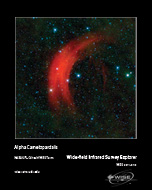



|
March 10, 2011 - Speed Demon Creates a Shock Just as some drivers obey the speed limit while others treat every road as if it were the autobahn, some stars move through space faster than others. NASA’s Wide-field Infrared Survey Explorer, or WISE, captured this image of the star Alpha Camelopardalis, or Alpha Cam in astronomer-speak, speeding through the sky like a motorcyclist zipping through rush-hour traffic. The supergiant star Alpha Cam is the bright star in the middle of this image, surrounded on one side by an arc-shaped cloud of dust and gas, colored red in this infrared view. Such fast-moving stars are called runaway stars. The distance and speed of Alpha Cam is somewhat uncertain. It is probably somewhere between 1,600 and 6,900 light-years away and moving at an astonishing rate of somewhere between 680 and 4,200 kilometers per second (between 1.5 and 9.4 million miles per hour). It turns out that WISE is particularly adept at imaging bow shocks from runaway stars. Previous examples can be seen around zeta Ophiuchi , AE Aurigae, and Menkhib. But Alpha Cam cranks things up into a different gear. To put its speed into perspective, if Alpha Cam were a car driving across the United States at 4,200 kilometers per second, it would take less than one second to travel from San Francisco to New York City! Astronomers believe runaway stars are set into motion either through the supernova explosion of a companion star or through gravitational interactions with other stars in a cluster. Because Alpha Cam is a supergiant star, it gives off a very strong wind. The speed of the wind is boosted in the forward direction the star is moving in space. When this fast-moving wind slams into the slower-moving interstellar material, a bow shock is created, similar to the wake in front of the bow of a ship in water. The stellar wind compresses the interstellar gas and dust, causing it to heat up and glow in infrared. Alpha Cam’s bow shock cannot be seen in visible light, but WISE’s infrared detectors show us the graceful arc of heated gas and dust around the star. The red arc of Alpha Cam adds to collection of colorful objects in WISE images taken of the constellation Camelopardalis, or the Giraffe. The gaudily clad giraffe has what looks like a ruby choker above an emerald necklace just to the southeast, as well as an ankle bracelet. The colors used in this image represent specific wavelengths of infrared light. Stars are seen primarily in blue and cyan (blue-green), because they are emitting light brightly at 3.4 and 4.6 microns. Green represents 12-micron light, primarily emitted by dust. The red of the blow shock represents light emitted at 22 microns. Image Credit: NASA/JPL-Caltech/WISE Team |
|||||||||||||||||||
|
||||||||||||||||||||
|
|||

